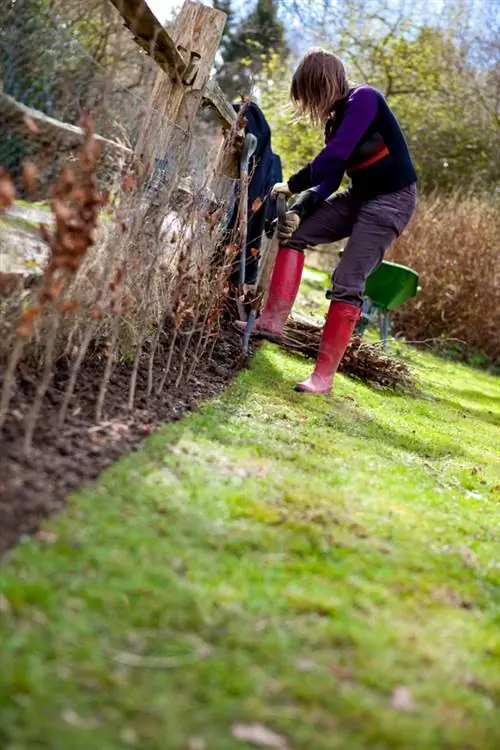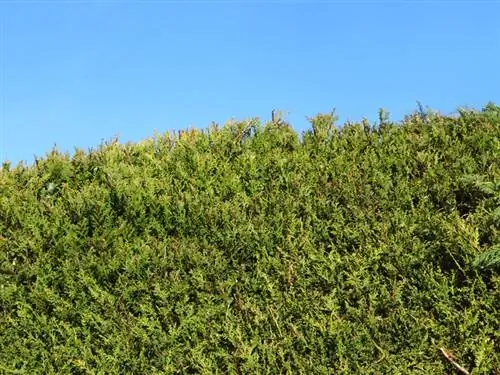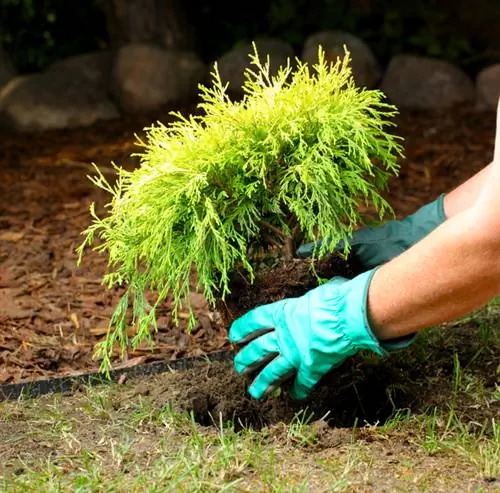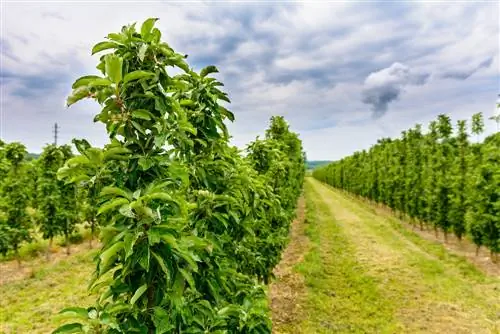- Author admin [email protected].
- Public 2023-12-25 17:45.
- Last modified 2025-01-23 11:22.
It is considered the incarnation of an evergreen hedge plant. Thanks to its compatibility with cutting, it maintains its harmonious shape at all times and gives the garden a very well-kept appearance. It is not by chance that the wonderful columnar cypress is so popular. The following answers to frequently asked questions will tell you how to properly cultivate the blue cypress.
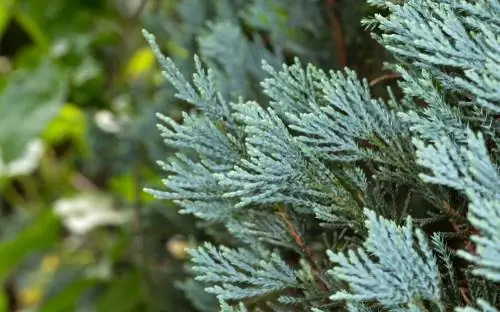
How do you properly care for a blue cypress?
The blue cypress is an evergreen hedge plant that is known for its topiary and harmful poison content. Optimal care includes regular watering, organic fertilizer, topiary, thinning and protection from pests.
Care tips
So that a columnar cypress meets expectations both as an elegant solitaire and as a majestic hedge, this care program creates the optimal conditions:
- Do not let the root ball dry out at any time of the year
- Ideally water with low-lime water
- You can choose to fertilize organically from March to August or apply a slow-release fertilizer in March and June
- Topiary pruning in several stages, instead of a deep pruning
- Thoroughly thin out the columnar cypress in early spring
Please do not forego the protection of gloves, safety glasses and long-sleeved clothing when carrying out care work. The high poison content of a blue cypress should not be underestimated.read more
Which location is suitable?
One of the many advantages of a columnar cypress is its flexible adjustment to light and temperature conditions. The conifer achieves its optimum in sunny, warm locations, but also thrives in partial shade and light shade. The condition of the soil is more important for vital growth. First-class drainage is at the top of the wish list, closely followed by a humus-rich, nutrient-rich, loose structure with a slightly acidic pH value of 5-6.
The correct planting distance
So that the columnar cypress quickly forms an opaque hedge, the correct planting distance is of utmost importance. Given the slim stature, which is maintained even at a height of 300 cm or more, the distance between them should not be too generous. If you arrange the blue cypresses at a distance of 30 to 50 cm from each other, you are exactly right.read more
What soil does the plant need?
You will have a lot of fun with a hedge of blue cypresses if the soil is deep, humus-rich, loose and slightly acidic. If the substrate quality at the planned location does not meet the ideal conditions, an adequate compensation can be created with the help of soil additives. The addition of acidic leaf and needle compost or Epsom s alt reduces a pH value that is too high. Quartz sand, fine grit or lava granules ensure better permeability. Lean soil is supplemented with mature compost, horn shavings, bark humus or horse manure.
Cut the blue cypress correctly
It is primarily the gentle pruning tolerance that makes a columnar cypress the ideal hedge plant. While the blue cypress can grow freely as a solitary plant without the need for annual pruning, as a well-maintained, evergreen enclosure it requires the repeated use of hedge trimmers. How to handle it correctly:
- Carry out light topiary cuts repeatedly from April to August
- Ideally cut in small stages, instead of an extensive pruning
- Do not cut into old wood as these branches will turn brown
At the end of winter, thin out the columnar cypress thoroughly. Dead wood, inward-facing shoots and shoots that rub against each other are cut off at the base. Make all other cuts so that a few millimeters of green plant tissue remain on the branch from which the conifer can sprout again.read more
Watering blue cypress
If a columnar cypress is subjected to drought stress, this deficiency will have a negative impact on growth or put an end to the life of the plant. Therefore, water the coniferous tree regularly as soon as the soil has dried on the surface. Ideally, you should pamper the false cypress with collected rainwater, soft pond water or decalcified tap water.
Fertilize blue cypress properly
Starting fertilization in March/April awakens the spirits of your columnar cypress. You can either administer a long-term fertilizer, which is used again in June, or fertilize purely organically. If the blue cypress receives a portion of compost, horn shavings, horse manure or guano granules every 30 days, its nutrient needs are met. In August, the application of fertilizer is stopped so that the plant matures before winter.read more
Diseases
In unfavorable locations with little sunlight, soil that is too dry or moist, fungal spores of various origins have an easy time of it. As symptoms of these widespread diseases, the tips of the needles wilt and then turn yellow and brown. In the early stages there is still hope by cutting off the diseased plant parts and disposing of them with household waste. However, if this requires cutting into the old wood, it is better to dispose of the affected columnar cypress. There are currently no known effective control agents for home and allotment gardens. The same applies to the fungal infection honey fungus (Armillaria mellea).read more
Pests
Despite its toxic content, the columnar cypress is not immune to pest infestation. The following pests can affect a blue cypress tree:
- Thuja leaf miner: Fight with neem-containing and other approved insecticides
- Thuja bark beetle: Cut out affected areas, clearing is better if the infestation pressure is high
- Aphids: Spray repeatedly with a mix of 1 liter of water and 1 tablespoon each of soft soap and spirit
Since the symptoms of diseases and pests on a columnar cypress are similar in the form of yellow and brown discoloration, keep a careful lookout for the insects, their larvae and feeding damage.
Propagate blue cypress
It is easy to breed additional blue cypresses. To do this, tear off half-woody shoots so that a piece of the bark remains on them. With the leaves removed in the lower part, stick the branches directly into the ground and cover the bed with leaves. Alternatively, plant the cuttings in a pot with lean substrate, put a plastic bag over them and care for them in a partially shaded location until an independent root system has developed.
Is blue cypress poisonous?
The dark side of the majestic columnar cypress is reflected in its toxic content, which is harmful to he alth. Show enough respect for toxicity by wearing sturdy gloves, long-sleeved clothing, and safety glasses during all planting and care tasks. The clippings should never be disposed of in places that are accessible to animals, as consumption of small amounts causes a painful death.read more
Brown leaves
One of the most common problems in cultivating a columnar cypress is the brown discoloration of leaves and entire shoots. These causes are hidden behind it:
- Lack of light
- Drought stress
- Waterlogging
- Soil compaction
- Nutrient Deficiency
- Fungal infections
- Pest Infestation
- Cutting back into old wood
- Dog urinary
- Frost Damage
In view of this long list, you will not be spared from putting all the conditions of your columnar cypress to the test.
Beautiful varieties
- Columnaris: The variety superstar thanks to its elegant stature, dense, blue-green needles and little tendency to baldness
- Elliwoodii: Magnificent columnar cypress with feathery, light leaves; with a maximum height of 250-300 cm ideal for small gardens
- Glauca: The variety impresses with its tightly upright habit, very slender; the perfect hedge plant
- Minima Glauca: Grows in a cushion shape up to 100 cm high and is recommended for rock gardens, the terrace and the grave
- Pemury Blue: With steel blue, soft needles, this columnar cypress also sets decorative accents as a solitary plant



